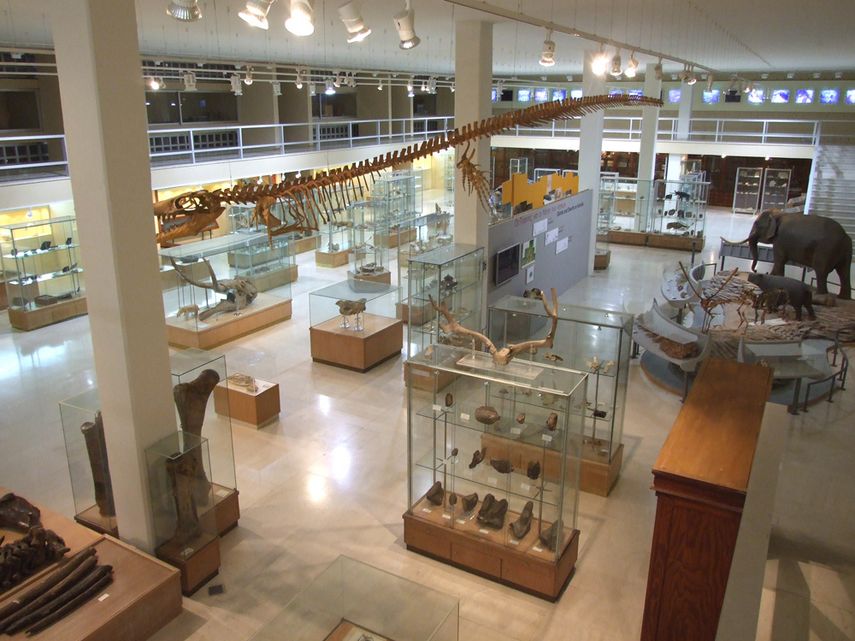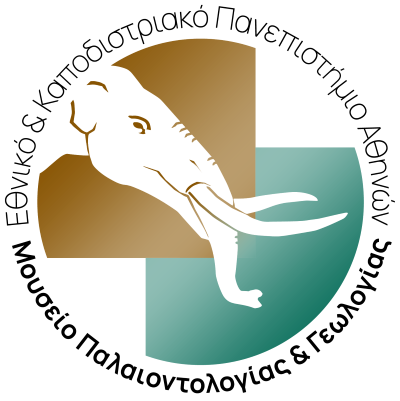MUSEUM OF PALEONTOLOGY AND GEOLOGY


NEW!
Online tour at the Museum of Paleontology and Geology
NEW!
Virtual tour of the exhibition titled "Giants and Dwarves on Islands"
The Museum of Geology & Paleontology of the University of Athens with the assistance of the artsteps.com platform presents the virtual tour of the exhibition "Giants and Dwarfs on islands". It shows how island fauna are affected by geological and climatic changes.
Ι. HISTORY
Starting with the founding of the Physiographic Society in 1835, the gathering of the first physiographic collections of animals, plants, fossils, rocks and minerals began, which formed the original core of the Physiographic Museum. The Physiographic Museum was incorporated into the University of Athens in 1858, while its collections were constantly enriched by donations, purchases and also the collection of material during research in Greece. In 1906, the autonomous course of the Paleontology and Geology Museum of EKPA began, which was housed on the ground floor of the building at the corner of Akadimias and Sina streets, in Athens. After 1932 it operated under a law that gave it many possibilities for research and ensured the protection of fossil mammals. In 1981 the Museum was moved to the University Campus, in the building of the School of Applied Sciences in the premises of the Department of Geology and Geoenvironment. In 1989, the first presentation outside the Museum of Pikermian fossils took place as part of the temporary exhibition Attic Landscape and Environment. In 1994, the first exhibition related to the Museum's excavations in the Charkadio Cave was held in Tilos. In 1998, the Natural History Collection of Vrisas-Lesvos was founded, which today functions as an annex of the Museum in a space granted for this purpose by the municipality of Polichnitos.
The collection of the Museum of Paleontology and Geology and the Annex includes fossils of animals and plants from all over Greece covering over 300 million years of our country's geological history and is notable for its richness (numbering tens of thousands of specimens), its good preservation and the uniqueness of of samples. In addition, samples from abroad, micropaleontological and stratigraphic collections as well as representations of paleoenvironments from the beginning of the 20th century are included. Its collections are enriched with findings that come exclusively from research programs of members of the Department of Historical Geology and Paleontology, paleontological excavations by faculty members and also from donations. Our immediate goal is to secure on an annual basis the elementary resources required for planned paleontological excavations and sample collection, improving the presentation of the exhibits, building three-dimensional representations of the most impressive animals that lived in Greece, as well as for the presentation of the geotectonic zones of Greece with the appropriate samples.
It is open to the public with the aim of disseminating knowledge and raising public awareness of issues related to the promotion and protection of our paleontological heritage. Perhaps the most important relevant step was taken in 1984, when after many years of related discussions by decision of the Central Archaeological Council, the site of the Pikermium excavations was declared an archaeological site of special natural beauty. The Museum, with the support of the faculty members of the field, organizes and carries out various exhibitions or events, e.g. Zappeion, Eugenide, Library of Alexandria, House of Cyprus, Tilos, Isoma Karion, etc. It receives daily visits from schools, organizes educational programs for students, while for a better understanding of the exhibits and the exhibition, the students are guided by its scientific staff ( most of them hold a doctorate degree).
ΙΙ. THE MUSEUM
In the exhibition area of the Museum, the visitor can admire some of the most important fossils found in Greece, as well as fossils-stations in the history of the evolution of life on earth, attempting a journey back in time guided by the fossils.
A central place in the Museum hall is occupied by the world-famous pikermian fauna with the primitive hippos, sabertooths, gazelles, giraffes, rhinoceroses and hyenas that lived about 7 million years before today in the plains that covered the Greek area as well as the famous fossil mammals of the Caryon Megalopolis Body that lived during the Pleistocene.
Exhibits include skeletal representations of endemic mammals, a hippopotamus and a pikermic rhinoceros. At the same time, a natural representation of a dwarf elephant from Tilos, Elephas tiliensis, as well as a life-size representation of a giant tortoise, which lived in the upper Miocene, were recently added to the Museum's collections. In 1985, in the context of the Vertebrate Paleontology Course's workshops and the implementation of postgraduate theses and theses, a systematic effort to preserve and record old collections that had remained in boxes for more than 100 years began. The creation of a core comparative collection and recently a database has also begun. Various holotypes have been added to the museum's collections, such as the skull of Choerolophodon chioticus, a primitive proboscidean that lived in Chios 14 million years ago. The plant fossils included in the exhibits are irrefutable witnesses of the evolution of plants of the past. On display are samples from the Oligocene of Evros, the Miocene, Kymi, Elassona and Vegora and the first appearance of the modern Mediterranean flora in Santorini 60,000 years before today.
The sea world is presented with fossilized molluscs, brachiopods, corals, sponges, echinoderms and fish as well as a replica of a Mosasaurus skeleton that lived 70 million years ago.
In May 2010, the exhibition was expanded to the B-C hall, which, apart from the permanent exhibits, is intended to host periodic exhibitions, a space designed for screenings and events, as well as a space that functions for the implementation of educational programs for students and pupils.
ΙΙΙ. ACTIVITIES
Its collections are visited annually by dozens of foreign researchers, postgraduate students and PhD candidates. It is a place of training and practical training for undergraduate and postgraduate students of the Department of Geology and Geoenvironment, the Department of Biology, students of the Department of Conservation of Antiquities and Works of Art of T.E.I. of Athens as well as the postgraduate students of the Interdepartmental Postgraduate Program in Museology of the EKPA.
Various research projects of various faculty members have been implemented in his laboratories, mainly concerning Vertebrate or Invertebrate Paleontology and Micropaleontology. Among them stand out the palaeontological excavations in Tilos (1971-2010) and the creation of a museum space on an area granted to the EKPA for 30 years, the excavations in Kerasia of Evia (1992-2006) and the creation of a permanent exhibition there, the palaeontological study of the collection of Rethymno which also led to the creation of the Paleontological Museum in Rethymno (1997-2008), the excavation in Vrisa (1998-2010) which led to the establishment of the annex, the excavations on the Katharos plateau (1998-2001), the Vraona excavations (1972- 1992), the excavations in Ayia Napa and the Xylophago Coast of Cyprus (2001-2010) and the excavations in Libya (2007-2010). In the past, the role of the Museum was also very important in highlighting the petrified forest of Lesvos, thus contributing to the study and dissemination of knowledge to society as a whole.
During the Academic year 2011-2012, the Museum of Paleontology and Geology started the pilot program "Sunday Morning at the Museum" opening to the public 12 Sunday mornings. The program was a great success and an effort will be made to continue this year as well, organizing - in addition to the educational programs "The Little Digger" and "Preserving a Treasure" for children - speeches, presentations of paleontological and/or geological interest, as well as scientific updates in showroom.
Museum Committee:
| Name | Position | Phone Number | |
| Efterpi Koskeridou | Museum Director, Professor | ekosker[at]geol.uoa[dot]gr | +30 210 727 4165 |
| Chariklia Drinia | Professor | cntrinia[at]geol.uoa[dot]gr | +30 210 727 4394 |
| Sokratis Roussiakis | Assoc. Professor | srousiak[at]geol.uoa[dot]gr | +30 210 727 4169 |
Contact
Postal Address: Department of Geology and Geoenvironment, University Campus 157 84, Zografou Athens
Phone Numbers: +30 210 727 4086, +30 210 727 4202
E-mail: ekosker@geol.uoa.gr
url: http://paleo-museum.uoa.gr/paleontology
facebook page: https://www.facebook.com/PalaeontologyMuseumAthens
twitter account: https://twitter.com/MuseumPalGeoUoA
The Natural History Collection in Lesvos has been operating since 1998 as an annex of the Museum of Paleontology and Geology and operates in collaboration with the Local Government, it is the Natural History Museum of Vrisa, Lesvos.
The museum's collections feature unique finds such as mammoths, rhinoceroses, antelopes, gazelles, giant tortoises, oversized horses, bipedal monkey families, etc.
Contact
Postal Address: Vrissa Polichnitou, Lesvos
Phone Number: +30 22520 61890